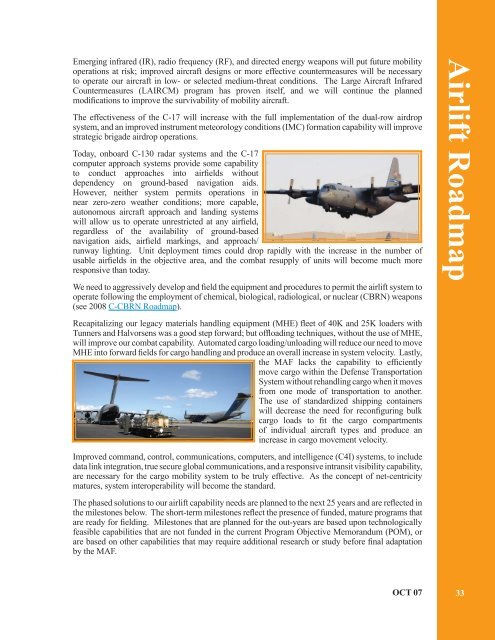Air Mobility Plan, 2008 - The Black Vault
Air Mobility Plan, 2008 - The Black Vault
Air Mobility Plan, 2008 - The Black Vault
Create successful ePaper yourself
Turn your PDF publications into a flip-book with our unique Google optimized e-Paper software.
Emerging infrared (IR), radio frequency (RF), and directed energy weapons will put future mobility<br />
operations at risk; improved aircraft designs or more effective countermeasures will be necessary<br />
to operate our aircraft in low- or selected medium-threat conditions. <strong>The</strong> Large <strong>Air</strong>craft Infrared<br />
Countermeasures (LAIRCM) program has proven itself, and we will continue the planned<br />
modifications to improve the survivability of mobility aircraft.<br />
<strong>The</strong> effectiveness of the C-17 will increase with the full implementation of the dual-row airdrop<br />
system, and an improved instrument meteorology conditions (IMC) formation capability will improve<br />
strategic brigade airdrop operations.<br />
Today, onboard C-130 radar systems and the C-17<br />
computer approach systems provide some capability<br />
to conduct approaches into airfields without<br />
dependency on ground-based navigation aids.<br />
However, neither system permits operations in<br />
near zero-zero weather conditions; more capable,<br />
autonomous aircraft approach and landing systems<br />
will allow us to operate unrestricted at any airfield,<br />
regardless of the availability of ground-based<br />
navigation aids, airfield markings, and approach/<br />
runway lighting. Unit deployment times could drop rapidly with the increase in the number of<br />
usable airfields in the objective area, and the combat resupply of units will become much more<br />
responsive than today.<br />
We need to aggressively develop and field the equipment and procedures to permit the airlift system to<br />
operate following the employment of chemical, biological, radiological, or nuclear (CBRN) weapons<br />
(see <strong>2008</strong> C-CBRN Roadmap).<br />
Recapitalizing our legacy materials handling equipment (MHE) fleet of 40K and 25K loaders with<br />
Tunners and Halvorsens was a good step forward; but offloading techniques, without the use of MHE,<br />
will improve our combat capability. Automated cargo loading/unloading will reduce our need to move<br />
MHE into forward fields for cargo handling and produce an overall increase in system velocity. Lastly,<br />
the MAF lacks the capability to efficiently<br />
move cargo within the Defense Transportation<br />
System without rehandling cargo when it moves<br />
from one mode of transportation to another.<br />
<strong>The</strong> use of standardized shipping containers<br />
will decrease the need for reconfiguring bulk<br />
cargo loads to fit the cargo compartments<br />
of individual aircraft types and produce an<br />
increase in cargo movement velocity.<br />
Improved command, control, communications, computers, and intelligence (C4I) systems, to include<br />
data link integration, true secure global communications, and a responsive intransit visibility capability,<br />
are necessary for the cargo mobility system to be truly effective. As the concept of net-centricity<br />
matures, system interoperability will become the standard.<br />
<strong>The</strong> phased solutions to our airlift capability needs are planned to the next 25 years and are reflected in<br />
the milestones below. <strong>The</strong> short-term milestones reflect the presence of funded, mature programs that<br />
are ready for fielding. Milestones that are planned for the out-years are based upon technologically<br />
feasible capabilities that are not funded in the current Program Objective Memorandum (POM), or<br />
are based on other capabilities that may require additional research or study before final adaptation<br />
by the MAF.<br />
<strong>Air</strong>lift Roadmap<br />
OCT 07 33
















